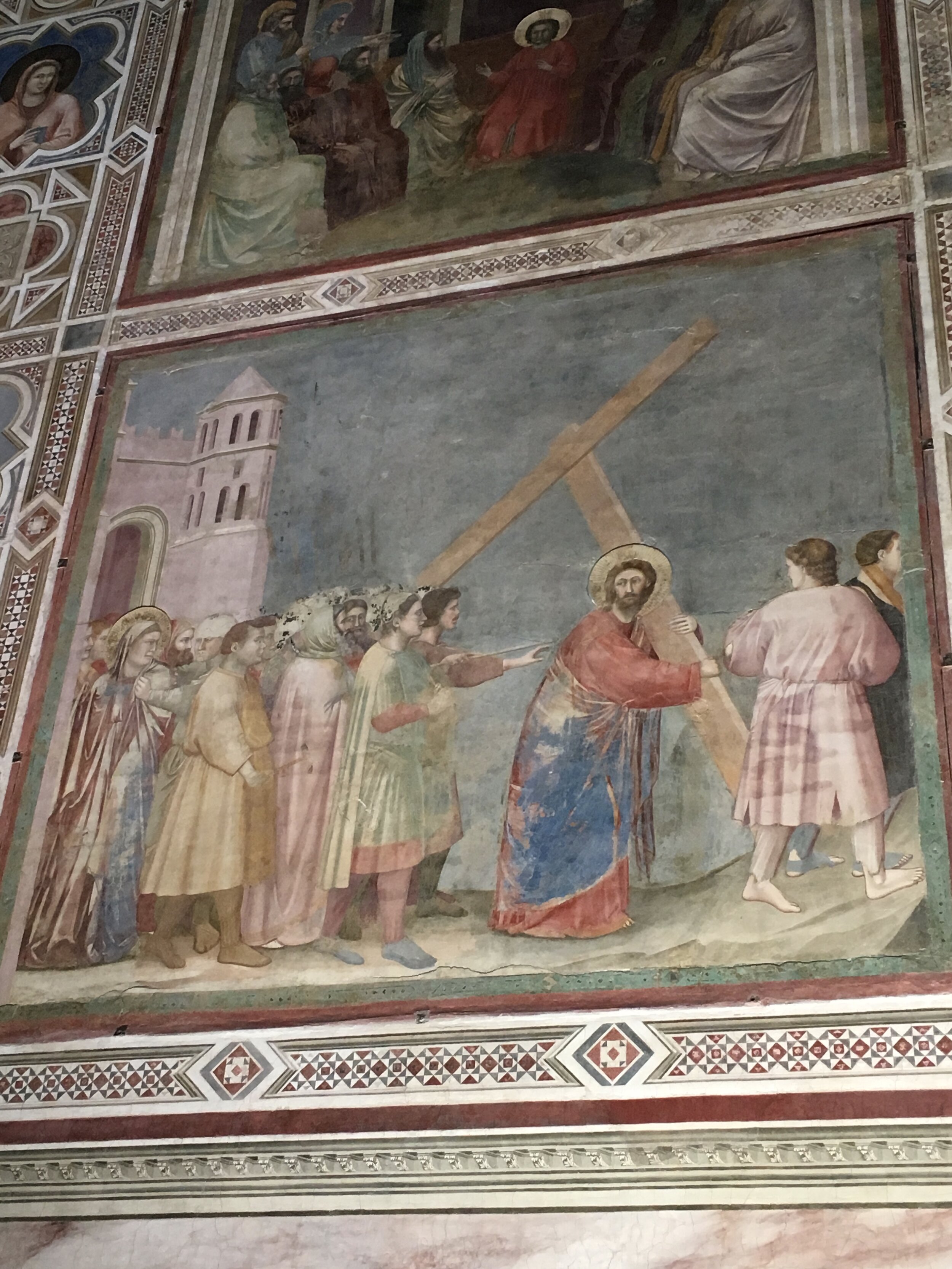Spots in Padova
Scrovegni Chapel
This chapel is seminal in the history of art; it was frescoed by Giotto between 1303-1305, and it depicts the Life of the Virgin and the Life of Christ. You might have gathered that I like art history. It was my minor in college, and while I emphasize many works with art historical merit, the urgency over visiting this chapel (if you are wondering) is, in part, because access is limited. The frescos were deemed vulnerable and many restoration efforts were carried out in the 19th and 20th centuries. Although they are now considered stable, I do not take any chances with the opportunity to visit masterpieces from over 7 centuries ago. The other reason the frescos are so special is that they are considered a bridge between the Gothic and Renaissance styles. In fact, Giotto created what is now known as Proto-Renaissance work which added an element of realism to painting and directly influenced later Renaissance artists. As explained in an entry on Assisi, Giotto worked under the master painter, Cimabue. Most experts agree that Giotto ‘surpassed his master’ to create this gateway towards the revolutionary Renaissance style. Most prominently, you will be able to observe how Giotto started to experiment with prospective, creating the appearance of three dimensional space and also adding diverse human emotions to his figures facial expressions, breaking the mould of Byzantine conventions. You can find out more about some of Giotto’s innovative techniques here. Regarding this chapel, if it is a priority while in Padova, I strongly recommend that you book online, in advance. Similar to the experience of visiting Di Vinci’s The Last Supper in Milan, only 25 guests are admitted at a time as it is necessary to ‘stabilise the interior microclimate’.
Prato della valle
This ‘prato’ which literally translates to ‘meadow’ has existed as a public space since at least Roman times. The area has the title of largest ‘square’ in Italy, and it has a powerful effect when you approach it from any angle. In fact, the area measures about 90,000 square meters and forms a unique elliptical shape. The central green space, the island area, is called the l'Isola Memmia, which is connected by bridges over a small canal and surrounded by statues in an interior and exterior ring. The 78 statues were created between 1775 and 1883 by various artists, and they depict historical figures. One of the statues depicts Andrea Memmo, the architect responsible for realizing the project started in 1775, and interestingly, “statues of the venetian doges, which have been destroyed by Napoleon in 1797.” You can view a list of all figures on the Wikipedia page.
Two important basilicas
Sant’Antonio
This important church is not far from the Prato della valle described above. It is dedicated to the Portuguese but oft called ‘Saint Anthony of Padova’ who died in this city in 1231. Construction on the basilica started one year after his death and was completed in 1310. Saint Anthony is perhaps most famous for being the saint associated with ‘lost things.’ As a child, in a Catholic context, it is common to hear ‘pray to Saint Anthony’ if you are complaining about the misplacement of an object. The cathedral is grand and imposing, but interestingly, it does not represent one particular architectural style; it has a number of impressive domes recalling the aesthetics of the famous San Marco in Venice, but has other Romanesque, Byzantine and some gothic features. The revered Saint Anthony was ultimately buried here, and as you can imagine, it is a popular pilgrimage site. One of the uncanny treasures (as is often the way with Catholic relics) to behold is the Saint’s tongue. According to legend, when his body was exhumed thirty years after death to be moved to the great basilica, his body was quite decomposed, but his tongue seemed to still have life. In fact, it reportedly ‘glistened’. Because Saint Anthony was a renowned and inspirational speaker, the relic serves a symbolic purpose. Although the tongue’s permanent home is the basilica, it was taken on tour for ‘the 750th anniversary of the discovery of the deceased saint’s holy relics.’ Read more about it here.
Santa Giustina
Santa Giustina is also located within the vicinity of the Prato della valle. The namesake, Justina of Padua, was a 4th century noblewoman who was known to visit imprisoned Christians when the growing religion was still considered illegal in the Roman Empire. Ultimately, she was taken before the the Roman prefect, Maximian, and ordered to death by sword for not renouncing her faith. The basilica was originally built in the 6th century but was reconstructed in the 17th century. According to the Wikipedia page, “the Basilica of Santa Giustina is one of the seventh largest in Italy.” Indeed, the interior space feels massive when you step inside.



